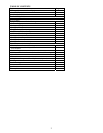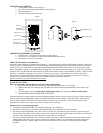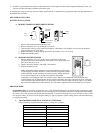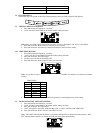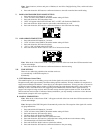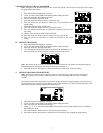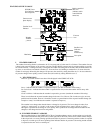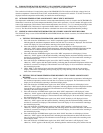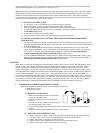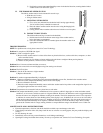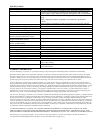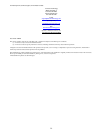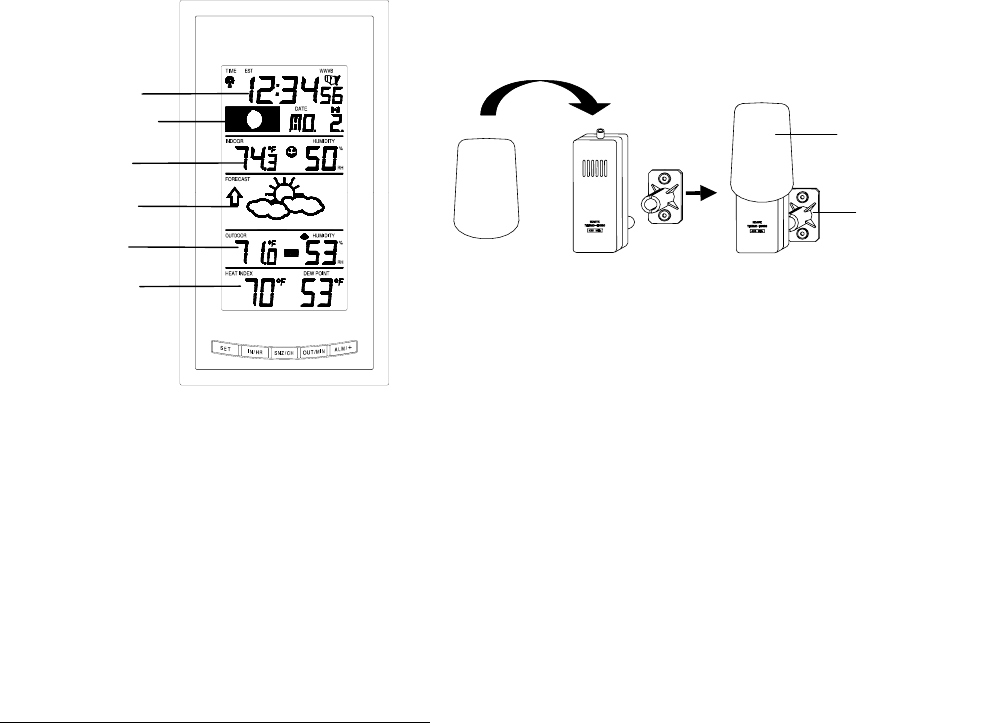
3
Moon Phase
and Date LCD
INVENTORY OF CONTENTS
1. The WS-9043U weather station (Figure 1)
2. One TX4U remote temperature/humidity sensor (Figure 2)
3. Mounting hardware
4. Instruction manual and warranty card.
ADDITIONAL EQUIPMENT (not included)
1. Three fresh AA 1.5V batteries for the indoor weather station.
2. Two fresh AA 1.5V batteries for the remote temperature/humidity sensor.
3. One Philips screwdriver for mounting.
ABOUT WWVB (Radio Controlled Time)
The NIST (National Institute of Standards and Technology—Time and Frequency Division) WWVB radio station is located in Ft.
Collins, Colorado, and transmits the exact time and date signal continuously throughout the United States at 60 kHz. The signal
can be received up to 2,000 miles away through the internal antenna in the Weather Station. However, due to the nature of the
Earth’s Ionosphere, reception is very limited during daylight hours. The weather station will search for a signal every night when
reception is best. The WWVB radio station derives its signal from the NIST Atomic clock in Boulder, Colorado. A team of atomic
physicists is continually measuring every second, of every day, to an accuracy of ten billionths of a second per day. These
physicists have created an international standard, measuring a second as 9,192,631,770 vibrations of a Cesium-133 atom in a
vacuum. For more information on the atomic clock and WWVB please see the NIST website at
http://www.boulder.nist.gov/timefreq/stations/wwvb.htm
.
QUICK SET-UP GUIDE
Hint: Use good quality Alkaline Batteries and avoid rechargeable batteries.
1. Have the indoor weather station and remote temperature/humidity sensor 3 to 5 feet apart.
2. Batteries should be out of both the indoor weather station and remote temperature/humidity sensor units for 10
minutes.
3. Place the batteries into the remote temperature/humidity sensor first then into the indoor weather station.
4. DO NOT PRESS ANY BUTTONS FOR 15 MINUTES.
In this time the indoor weather station and remote temperature/humidity sensor will start to talk to each other and the display will
show the indoor temperature/humidity, outdoor temperature/humidity, heat index and dew point. If the indoor weather station
does not display all information after the 15 minutes please retry the set up as stated above. After all information has been
displayed for 15 minutes you can place your sensors outdoors and set your time.
Important Notes on Set-up and Operation
• The remote temperature/humidity sensor should be placed in a dry, shaded area.
• Fog and mist will not harm your remote temperature/humidity sensor but direct rain must be avoided.
• The remote temperature/humidity sensor has a range of 330 feet. Any walls that the signal will have to pass through will
reduce distance. An outdoor wall or window can have up to 30 feet of resistance and an interior wall can have up to 20 feet of
resistance. Your distance plus resistance should not exceed 330 ft. in a straight line.
• The remote temperature/humidity sensor transmits a signal every minute. After the batteries have been installed, the indoor
weather station will search for the signal for a duration of 4 minutes. If there is no temperature or humidity reading in the
OUTDOOR LCD after 4 minutes, make sure the units are within range of each other, or repeat the battery installation
procedure.
Figure 1
Time LCD
F
orecast LCD
Indoor LCD
Outdoor LCD
Figure 2
Heat index and
Dew point LCD
Rain protection cover
Wall mounting base




